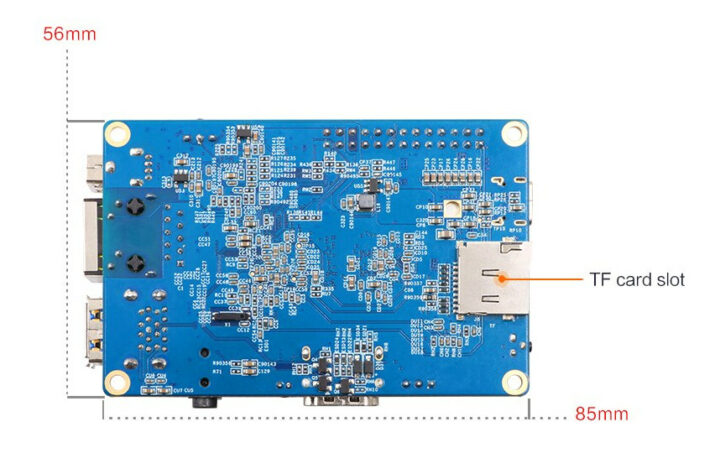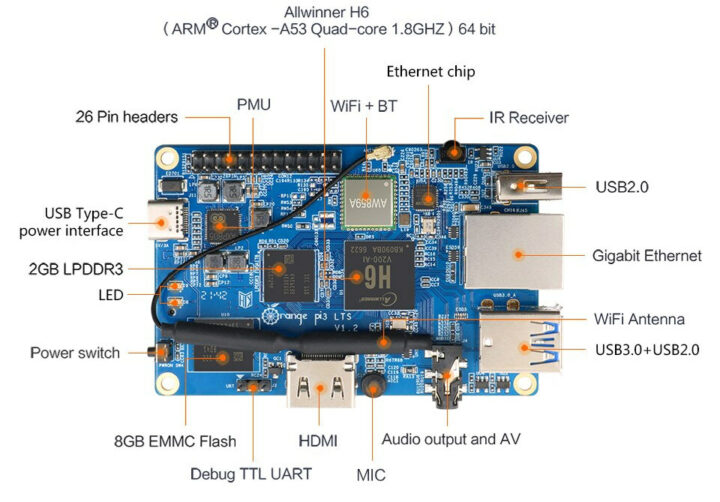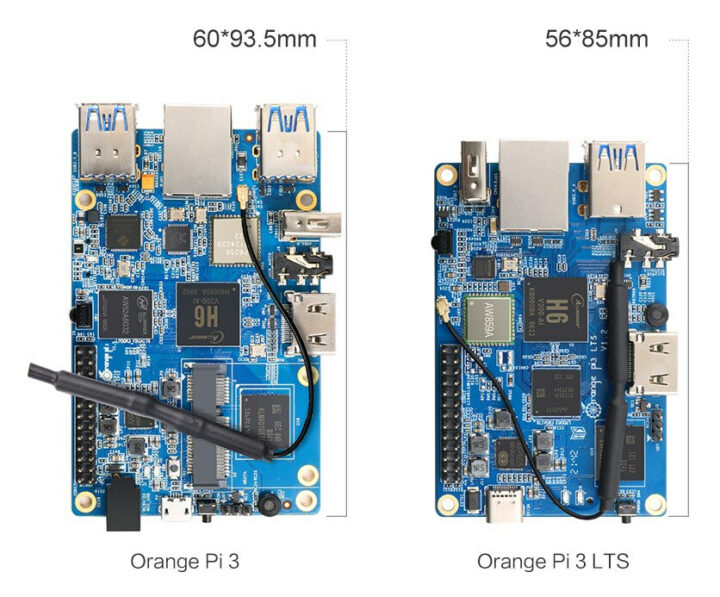Orange Pi 3 LTS is a cost-down, more compact version of Orange Pi 3 SBC launched in 2019 with Allwinner H6 quad-core Cortex-A53 processor, Gigabit Ethernet, four USB 3.0 ports, and mPCIe socket with a PCIe x1 Gen2 lane. AFAICR, the latter never really worked well due to a botched implementation in the SoC.
The new slimmed-down Orange Pi 3 LTS is sized like a business card, loses the mostly useless mPCIe socket from the original board, comes with 2GB LPDDR3 RAM (no more 1GB RAM option), a lower number of USB ports, USB Type-C power input, and an Allwinner AW859A WiFi and Bluetooth module replaces the Ampak AP6256 module from the original board.
Orange Pi 3 LTS specifications:
- SoC – Allwinner H6 quad-core Cortex A53 processor clocked at up to 1.8 GHz with Arm Mali-T720MP2 GPU supporting OpenGL ES 3.1/3.0/2.0/1.1, DirectX 11
- System Memory – 2GB LPDDR3 (before 1GB or 2GB)
- Storage – 8GB eMMC flash and microSD card slot (note: no more option without eMMC flash)
- Video & Audio Output – HDMI 2.0a up to 4Kp60, 3.5mm AV jack with composite video and stereo audio
- Audio Input – Built-in microphone
- Video Decoding – 10-bit H.265 up to 4Kp60, 6Kp30, VP9 and H.264 up to 4Kp30, AVS+/AVS up to 1080p60
- Networking & Wireless Connectivity
- USB – 1x USB 3.0 port (no more USB 3.0 hub chip), 2x USB 2.0 host ports
- Expansion – 26-pin header with GPIOs, I2C, UART, SPI, 5V, 3.3V, and GND
- Debugging – 3-pin serial console / UART header
- Misc – Power button; IR receiver; power and status LEDs
- Power Supply – 5V/3A via USB-C port (instead of 5V/2A via power barrel jack or micro USB port); AXP805 PMIC
- Dimensions – 85 x 56 mm (was 90 x 64 mm)
 The single board computer is said to support Android 9.0, Ubuntu, and Debian with Orange Pi’s maintained OS images and PDF documentation soon to be offered on their website. For some reason, Shenzhen Xunlong Software will also start selling the board before their image and documentation is made public,
The single board computer is said to support Android 9.0, Ubuntu, and Debian with Orange Pi’s maintained OS images and PDF documentation soon to be offered on their website. For some reason, Shenzhen Xunlong Software will also start selling the board before their image and documentation is made public, which should be in a few weeks [Update: I’ve been told everything will be uploaded on Monday]. You can always check Orange Pi 3 docs for reference. Orange Pi 3 is also supported by Armbian with Ubuntu 20.04 Focal and Debian 11 BullsEye image available, and I suspect those images should work on Orange Pi 3 LTS, possibly minus the WiFi and Bluetooth.
Orange Pi 3 LTS single board computer can be purchased now for $35 on either Aliexpress or Amazon US. For reference, that’s about the same price as the original Orange Pi 3 board with 2GB LPDDR3, but no eMMC flash, when it was launched in 2019.

Jean-Luc started CNX Software in 2010 as a part-time endeavor, before quitting his job as a software engineering manager, and starting to write daily news, and reviews full time later in 2011.
Support CNX Software! Donate via cryptocurrencies, become a Patron on Patreon, or purchase goods on Amazon or Aliexpress. We also use affiliate links in articles to earn commissions if you make a purchase after clicking on those links.






AFAICR = ? I google it but seriously….
AFAICR: as far as I can recall/remember
These are some bad habits some of us who have spent a lot of time on mailing lists got. I didn’t even notice because I probably naturally parsed it as a sentence! But 25 years ago all those commonly used acronyms were extremely difficult for me.
I just assumed those acronyms were all well known. Maybe I should avoid using them in the future.
I noticed that among non-native speakers they are not much known, except from those spending time on lists and forums who practice them a lot. So yes it’s better to avoid them I think, given the broad audience of your site.
Even if you are a native english speaker, unless you see or use it often, you wont know it.Netlingo is different from English and has tons subgroups.
For example how many here know what MTL is? SWIM.
Just explore Subreddits and you’ll find tons of new ones
FWIW, you can use what you want, it is your blog afterall.
for me, as a non native english speaker, googling it is part of the fun.
As Far As I Can Remember
From their website and pictures, the Gigabit chip has been replaced by the YT8531C like they have done on the R1 Plus LTS.
Is the allwinner wifi working nowadays? Or still that same crap?
Same crap, same broken h6, same bad support. Worth no $35. Rpi has much better support for even crappier Broadcom shit, and therefore better money spent.
My question was about the wifi not the H6…
And if one wants an orange pi why even bothering recommending an rpi?
If one wants orange pi he can buy one. Why even bothering asking about it? They have terrible support for all ICs on the board, including always broken wifi. Nothing has changed over past years.
Who cares? Wi-Fi on SBC is one huge sh*t show in general since the only reasonable choices are the modules on Raspberries (which you don’t want for different reasons) or maybe some selected modules from Radxa. The rest of the Ampak/Broadcom/Cypress stuff is vulnerable at least wrt Kr00k and most probably also wrt BroadPwn.
Is it a hw or a driver or a fw issue?
Can’t be that a whole fleet of bcm/cyw wifis are useless beyond repair…
Software/firmware. And none of the SBC makers (except RPi Trading Ltd. and Radxa) seems to give a sh*t. From this point of view majority of SBC are as crappy as those crappy Android boxes…
Do we need the manufacturer to fix it? Or is there a way to fix it on our own?
The firmware are BLOBs so nope, the user can’t fix anything.
The chip maker has the fixes (Broadcom, then Cypress, now Synaptics)
All that’s missing is the SBC maker asking the chip maker for the fix to provide it to users. Unfortunately almost every SBC maker simply doesn’t give a shit… and that’s the situation of wireless security with SBC in 2022.
So the chipmaker doesn’t provide the blobs for non customers…
Means we can only fix it if one of the “good” manufacturers got the blob for exactly our module.
How I love this closed source concept. Lets not mainline it might just create issues for thefire n forget fraction…
So who is using these boards, and for what use, purpose?
I can see a lot of complaints on Facebook (in Thailand), about users having trouble purchasing Raspbarry Pi boards due to a lack of supply. So it can be an alternative.
They also work quite well with libreelec
I have a few of them, they mostly serve as paperweight.
From all the boards I have only RPI4 is used every once in a while
My rpi4 is still waiting for my hdmi adapter no idea who had this idea with mini/micro hdmi a nuisance my adapters hardly work would have to order the original adapter from Germany i suppose
I didn’t use an adapter, I used a cable that regular size at the one end and micro at the other end. Probably ordered from Ali or ebay.
I also used an el-cheapo adapter (from the same source) without problem, but I didn’t like the adapter connected to the hdmi of the RPI.It didn’t seem like a good and stable connection, so I moved to the cable
(and if you connect an adapter directly to the Pi you cannot use the 2nd port, not that I am using it)
still H6 and cortex-A53? I will expected something on cortex-A55… very dissapointing
As far as i know, There’s no difference between A53 vs A55 if they use the same memory and same clock speed (< 5%)
In my tests A55 is significantly faster than A53 (15-20%) and its memory speed is 2-3x (which likely contributes a lot to the overall performance gains). The A55 is a really well balanced core in my opinion.
> In my tests A55 is significantly faster than A53 (15-20%)
I guess it’s a matter of use case (as almost always), right?
Talking about use cases it’s really fascinating for what people seem to be using their SBC. Always operated fully loaded and only with stuff that stresses the CPU cores.
Nobody seems to be in normal SBC mode any more where a fast core on a crappy design (slow storage for the root fs) will be easily outperformanced by a slower core on a better designed device.
Try sbc with rk3568 you will see cortex a55 is much more faster… For example firefly roc 3568 or 3566
> you will see cortex a55 is much more faster
What exactly is your methodology to ‘see’ how much faster ‘the CPU core’ is?
The A55 is significantly faster at same clockspeed/process though. Almost 20% in specint, way more in specfp..
What is the possible highest GHz, at 22nm, 12nm. Seems 1.9GHz in Android boxes. That a natural limit or can A55 be pushed higher ?
The RK3568 pushes them to 2ghz iirc.
Always the same story whenever I’ve purchased these boards. Great specs – the selling point. Zero software support which makes them absolutely useless. It’s almost like they know people will buy them based on specs and they’ll languish in a drawer to be thrown out eventually. Good business model.
You can buy venerable RPi products if you need support. RPi forums are full of people who provide 24/7 support free of charge. You can ask noob questions or help with difficult business decisions.
If you want zero support, Allwinner has been one of the most famous chips with poor support. If you buy some Orange Pi board, for instance, the manufacturer might offer 2.6 binary kernel and some random fex binaries and the latest kernels won’t work on those boards anymore. The sunxi wiki tells they’ve stolen gpl code. So you have a crappy device that contains stolen code, possible keyloggers and trojans in the bootloader that doesn’t support standard uefi fat32, legacy kernel with no support..
I like it (except for the WIFI+BT), USB-C for power, smaller size.
Ethernet / LAN / RJ45 port should be low-profile like on Khadas VIMs and some Radxa boards. It save almost 50% height when stacking/casing.
eMMC should not be soldered but socketed like many other SBCs
The 1 USB3 port and 1 USB2 port are visually identical and bundled together WTF? Which one is which (top/bottom) ?
(Bundle USB3 and USB2) and separate USB2 – how it is.
(Bundle USB2 and USB2) and separate USB3 – how it should have been
This one looks promising even with h6. Where raspberry 2gb has rate increased. But this(I believe) can’t be used for media playback. Not very good with 720 or above resolutions due to support. But orange pi products are good. As mine zero is working. I bought it few months after launch and its still reliable to be put inside my cardboard handheld console as of today. I am interested in this one for a review. Its just that shipping from China is ban in India (not deliverable or really high charges for cheap products as well).